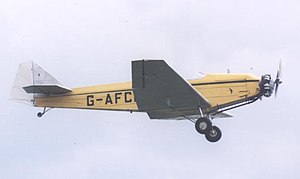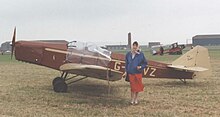Pobjoy Airmotors and Aircraft was a British manufacturer of small aircraft engines. The company was purchased by Short Brothers shortly before the start of World War II, production continuing until the end of the war.

The General Aircraft GAL.42 Cygnet II was a 1930s British single-engined training or touring aircraft built by General Aircraft Limited at London Air Park, Hanworth.

The Klemm Kl 35 is a German sporting and training aeroplane developed as a successor to the Kl 25. A product of Klemm Leichtflugzeugbau Gmbh it shared the same single-engine, cantilever low-wing configuration as the earlier machine, the major difference being the introduction of an inverted gull wing.

The Short S.16 Scion and Scion II were 1930s British two-engine, cantilever monoplanes built by Short Brothers and by Pobjoy Airmotors and Aircraft Ltd. in Rochester, Kent between 1933 and 1937. Altogether 22 Scion/Scion II aircraft were built and they provided useful service to operators working from small airstrips/water courses in many parts of the globe, including Europe, the Near and Middle East, Sierra Leone, Papua New Guinea and Australia. Many were impressed into the Royal Air Force during the Second World War, providing pilot ferry services, anti-aircraft co-operation and radar calibration duties. Of the civilian Scions, at least two were still operating in Australia in 1966, one having been re-engined with de Havilland Gipsy Minor engines.

The Foster Wikner Wicko was a 1930s British two-seat cabin monoplane built by the Foster Wikner Aircraft Company Limited at Southampton Airport, Hampshire.

Between 1920 and 1951 the Société des Moteurs Salmson in France developed and built a series of widely used air-cooled aircraft engines.

The Auster J/5 Autocar was a late 1940s British single-engined four-seat high-wing touring monoplane built by Auster Aircraft Limited at Rearsby, Leicestershire.
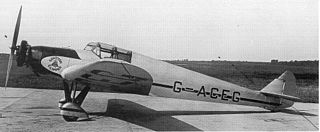
The Spartan Clipper was a British light touring aeroplane of the 1930s. It was a single-engine, two-seat, low-wing monoplane with a fixed tailwheel undercarriage.

The Miles M.28 Mercury was a British aircraft designed to meet the need for a training and communications plane during the Second World War. It was a single-engined monoplane of wooden construction with a twin tail and a tailwheel undercarriage with retractable main units.

The de Havilland Gipsy is a British air-cooled four-cylinder in-line aircraft engine designed by Frank Halford in 1927 to replace the ADC Cirrus in the de Havilland DH.60 Moth light biplane. Initially developed as an upright 5 litre capacity engine, later versions were designed to run inverted with increased capacity and power.

The Avro Avian is a series of British light aircraft designed and built by Avro in the 1920s and 1930s. While the various versions of the Avian were sound aircraft, they were comprehensively outsold by the de Havilland Moth and its descendants.
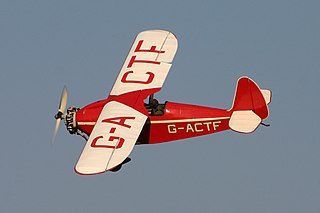
The Comper C.L.A.7 Swift is a British single-seat sporting aircraft designed and produced by the Comper Aircraft Company. It was the company’s first aircraft.

The B.A. Eagle was a light aircraft manufactured in the United Kingdom during the 1930s. It was a three-seat low-wing monoplane built by the "British Klemm Aeroplane Company" Production was limited, with 43 aircraft built.

The Pobjoy Niagara is a British seven-cylinder, air-cooled, radial, aero-engine first produced in 1934. The design ran at higher speeds than conventional engines, and used reduction gearing to lower the speed of the propeller. This led to a noticeable off-centre mounting for the propeller. The Niagara was a popular engine for light and experimental aircraft, well regarded due to its small diameter, smooth operation, low noise and innovative engineering.

The Caudron C.280 Phalène ("Moth") was a civil utility aircraft built in France during the 1930s. It was a high-wing braced monoplane of conventional configuration with fixed tailskid undercarriage. The pilot and two-three passengers were accommodated within an enclosed cabin. The structure was wooden throughout, with the forward fuselage skinned with plywood, and the rest of the aircraft fabric-covered.
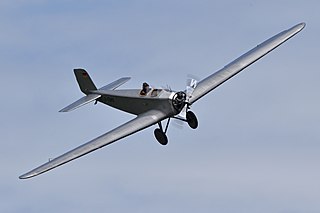
Klemm L 25, later Klemm Kl 25 is a successful German light leisure, sports and training monoplane aircraft, developed in 1928. More than 600 aircraft were built, and manufacturing licenses were sold to the United Kingdom and the United States.
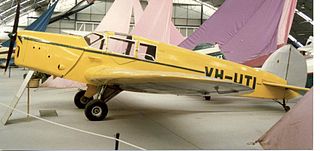
The British Aircraft Manufacturing Company Limited was a 1930s British aircraft manufacturer based at London Air Park, Hanworth, Middlesex, England.
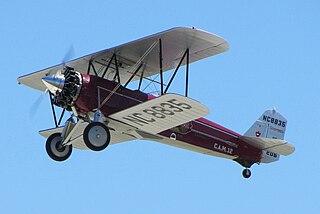
The Stearman C3 was an American-built civil biplane aircraft of the 1920s, designed by Stearman Aircraft of Wichita, Kansas. It was also the first Stearman aircraft to receive a type certificate.

British Salmson aero-engines refers to a series of small French designed, air-cooled radial aero engine that were produced by British Salmson Aero Engines Ltd, under license from Société des Moteurs Salmson, in Great Britain during the late 1920s and 1930s.
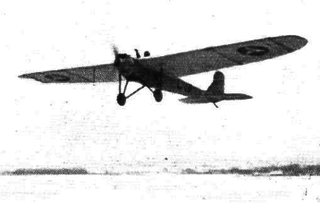
The Daimler L15, sometimes later known as the Daimler-Klemm L15 or the Klemm-Daimler L15 was an early two-seat low-powered light aircraft intended to popularise flying. In mid-career it flew as a glider.
